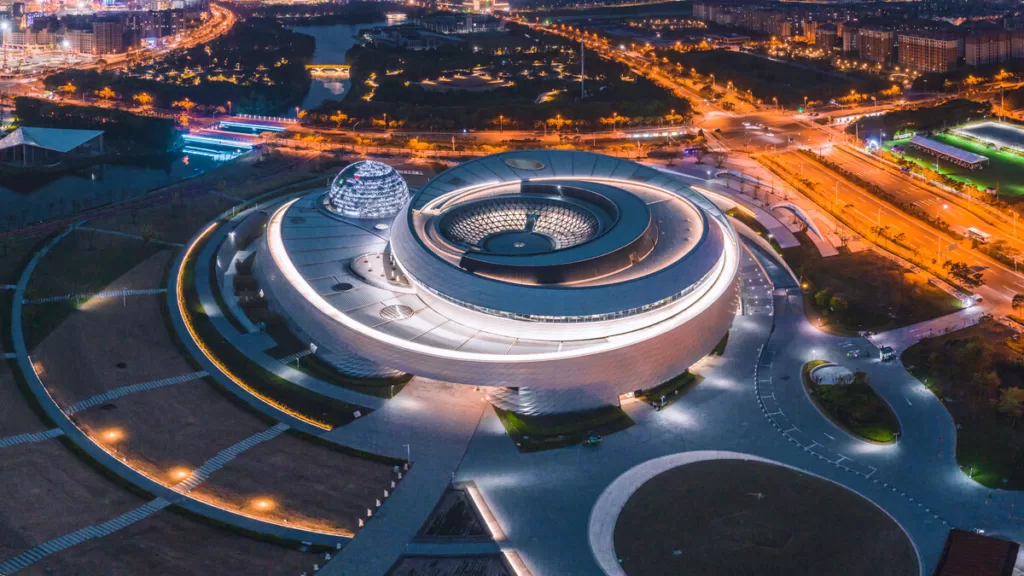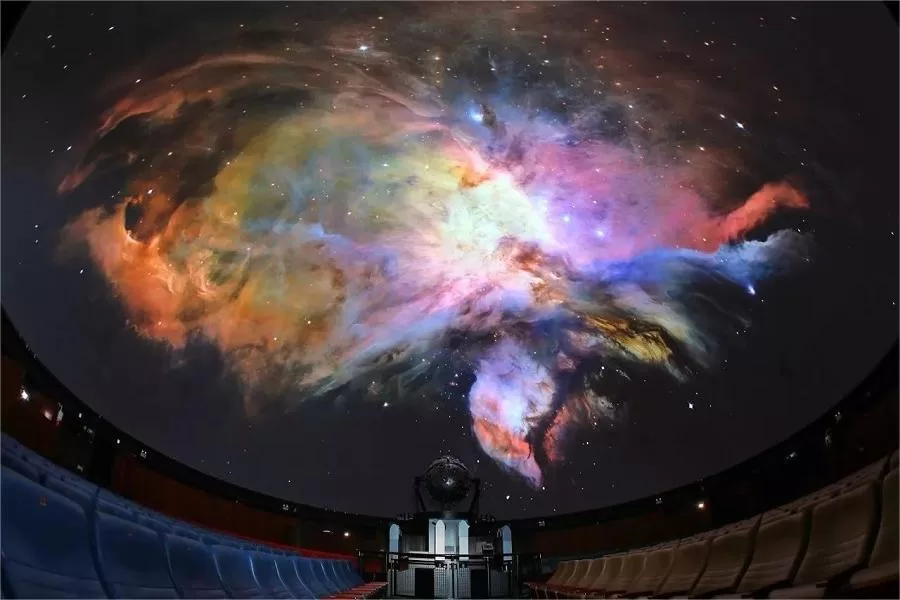Shanghai Astronomy Museum - Kaartje, openingstijden, hoogtepunten en tips


Shanghai Astronomy Museum, also known as Shanghai Planetarium (上海天文博物馆) is a state-of-the-art museum located in Shanghai, China. The museum is one of the largest of its kind in the world, covering an area of over 58,600 square meters. It was officially opened to the public in July 2021 and has quickly become a popular attraction for locals and tourists alike.
The museum’s architecture is stunning, featuring a unique design inspired by the astronomical observation instruments of ancient China. The museum’s exhibits are divided into four main areas: the Universe Gallery, the Earth Gallery, the Exploration Gallery, and the Future Gallery. Each area showcases different aspects of astronomy and space exploration, including the history of astronomy, the latest scientific discoveries, and the technology behind space exploration.
One of the highlights of the museum is the 22-meter digital dome theater, which offers visitors an immersive and interactive experience of space. The museum also houses a planetarium, a solar telescope, and a radio telescope, allowing visitors to observe the sun, stars, and other celestial objects up close.
Inhoudsopgave
- Basisinformatie
- Locatie en vervoer
- Highlights of Shanghai Astronomy Museum
- Vlog about Shanghai astronomy Museum
- Nuttige tips uit recensies
- Ander Wetenschapsmuseum in Shanghai
Basisinformatie
| Website | https://www.sstm-sam.org.cn/ |
| Geschatte lengte van de tour | 2 - 3 uur |
| Ticket Prijs | 30 RMB |
| Openingstijden | 9.30 – 16.00; Last admission: 15.00 |
| Telefoonnummer | 0086-021-50908563 0086-021-50685563 |
Locatie en vervoer
Shanghai Astronomy Museum is located in the suburban area of Shanghai, China, specifically at 380 Lingang Avenue in the Pudong New Area. To get there, you can choose the following ways:
Bus: Take Bus Shengang 1 or 1009, get off at Lingang Avenue Huanhu West 3rd Road Stop (临港大道环湖西三路站), and you will be standing right at the box office of the museum.
Metro: Take subway line 16, get off at Dishui Lake Station (滴水湖站), and walk about 600 meters along the road to the northwest to reach Shanghai Astronomy Museum.
Highlights of Shanghai Astronomy Museum
Digital Dome Theater

The digital dome theater is one of the main attractions at Shanghai Astronomy Museum. With a diameter of 22 meters and over 60 million pixels, the dome-shaped theater offers visitors an immersive and interactive experience of space. The high-resolution projection system allows visitors to see stars, planets, and galaxies in stunning detail. The theater can also simulate various celestial phenomena, such as meteor showers, eclipses, and supernovae. The theater’s advanced technology and high-quality visuals make it an unforgettable experience for visitors of all ages. The dome theater is a great way to explore the wonders of the universe and learn about the latest discoveries in astronomy and space science.
Solar Telescope

The solar telescope at Shanghai Astronomy Museum is a specialized telescope that allows visitors to observe the sun in real-time. It is specially designed to capture the sun’s surface features and provide a unique view of our nearest star. The telescope is equipped with a range of filters and instruments that allow visitors to see the sun’s surface in different wavelengths of light. The solar telescope is a great way to learn about the sun and its important role in our solar system. Visitors can observe sunspots, solar flares, and other phenomena that help us understand the workings of the sun and its impact on Earth.
Radio Telescope

The radio telescope at Shanghai Astronomy Museum is a fascinating exhibit that allows visitors to listen to the sounds of the universe. The telescope is specially designed to detect radio waves emitted by celestial objects, such as distant galaxies and pulsars. Visitors can listen to the signals picked up by the telescope through headphones and get a sense of the vastness and complexity of the universe. The radio telescope is a great way to learn about radio astronomy and the technology behind this field of study. It is also an excellent reminder of the importance of exploring the cosmos through a range of scientific disciplines and tools.
Exhibits

Shanghai Astronomy Museum offers a range of exhibits that cover different aspects of astronomy, space exploration, and related fields of study. The exhibits are divided into four main areas: the Universe Gallery, the Earth Gallery, the Exploration Gallery, and the Future Gallery. In the Universe Gallery, visitors can learn about the history of astronomy, the different types of celestial objects, and the latest discoveries in the field. The Earth Gallery focuses on the study of our planet, including geology, meteorology, and environmental science. The Exploration Gallery features exhibits on space exploration, including the technology and challenges involved in space travel. Finally, the Future Gallery explores the possibilities of space exploration and the potential for discovering new worlds and life forms beyond our solar system.
Architectuur

The architecture of Shanghai Astronomy Museum is a unique blend of traditional Chinese design and modern technology. The building’s curved roof and central atrium are inspired by the astronomical observation instruments of ancient China, while the modern glass and steel construction represents the latest technological advancements in space science. The museum’s overall design is intended to evoke a sense of wonder and curiosity about the universe. Inside the museum, visitors will find a spacious and well-lit interior, with curved walls and ceilings that add to the sense of immersion and awe.
Vlog about Shanghai astronomy Museum
Nuttige tips uit recensies
Planetarium Show: Separate tickets are required for the planetarium show, priced at 40 yuan per person for a duration of 30 minutes. The seats in the theater are comfortable, providing a relaxing experience especially after a day of exploration.
Food: Visitors have noted that the food inside the museum is expensive and not very appetizing. It’s recommended to avoid eating there if possible. Consider bringing your own snacks or dining elsewhere before or after your visit.
Bagage-opslag: The museum provides storage facilities for large items of luggage. Additionally, there are a few free lockers available for storing smaller belongings.
Verboden artikelen: It’s prohibited to carry lighters into the museum. However, if you accidentally bring one, you can retrieve it when leaving as staff members allow visitors to reclaim their lighters from a designated basket.
Special Exhibits: Each visitor is allowed to reserve only one session per day for the special exhibits. Below are the names, locations, durations, and capacity limits for these exhibits:
- Curiosity Planet: Near the B1 Galaxy Supply Station, lasting 45 minutes with a capacity of 60 people.
- Optical Celestial Hall: Located in the 1F Home Exhibition Area, to the left of the Earth model, lasting 5 minutes with a capacity of 80 people.
- Journey through the Milky Way: Next to the escalator in the 1F Home Exhibition Area, lasting 8 minutes with a capacity of 18 people.
- Heading to Mars: Located in the 1F Special Exhibition Hall, lasting 30 minutes with a capacity of 6 people.
- Fiction Theater: Located in the 2F Universe section, lasting 9 minutes with a capacity of 40 people.
- Wangshu Observatory: Located on the left-hand side of the main building exit, lasting 20 minutes with a capacity of 15 people.
- Xihe Solar Tower: Located on the right-hand side of the main building exit, lasting 30 minutes with a capacity of 15 people.
Ander Wetenschapsmuseum in Shanghai

Spoorwegmuseum Shanghai

Shanghai Wetenschaps- en Technologiemuseum

Shanghai Natuurhistorisch Museum